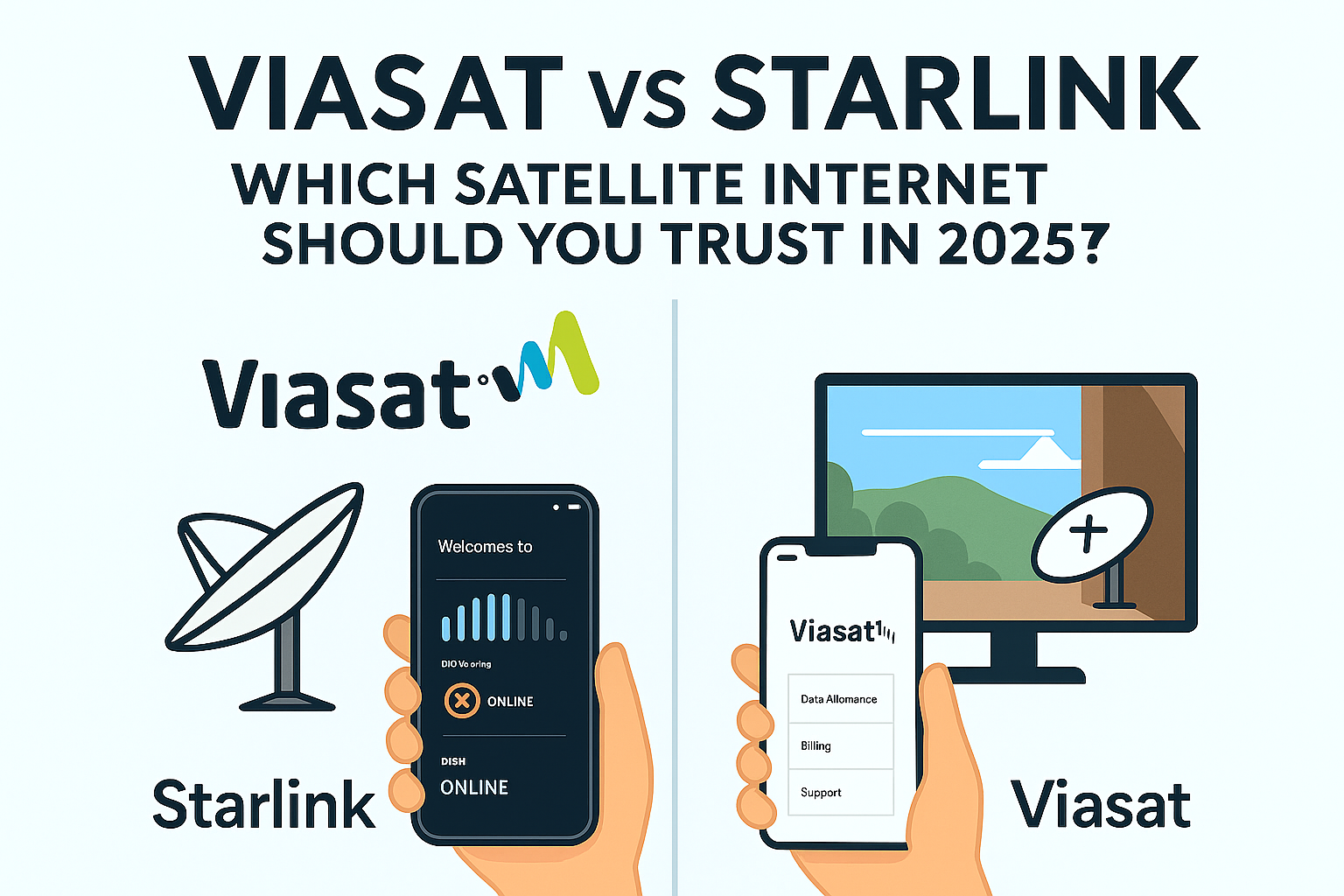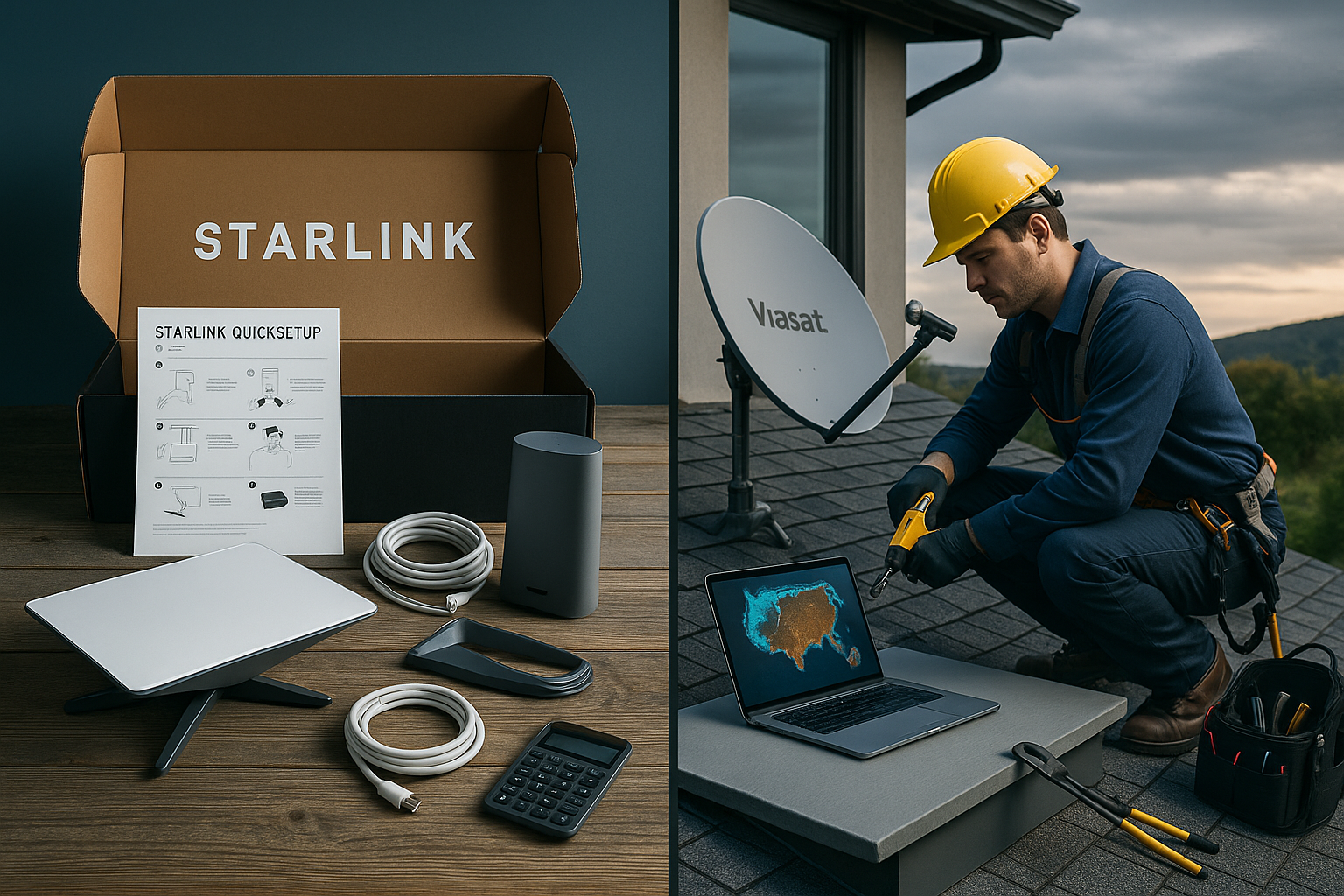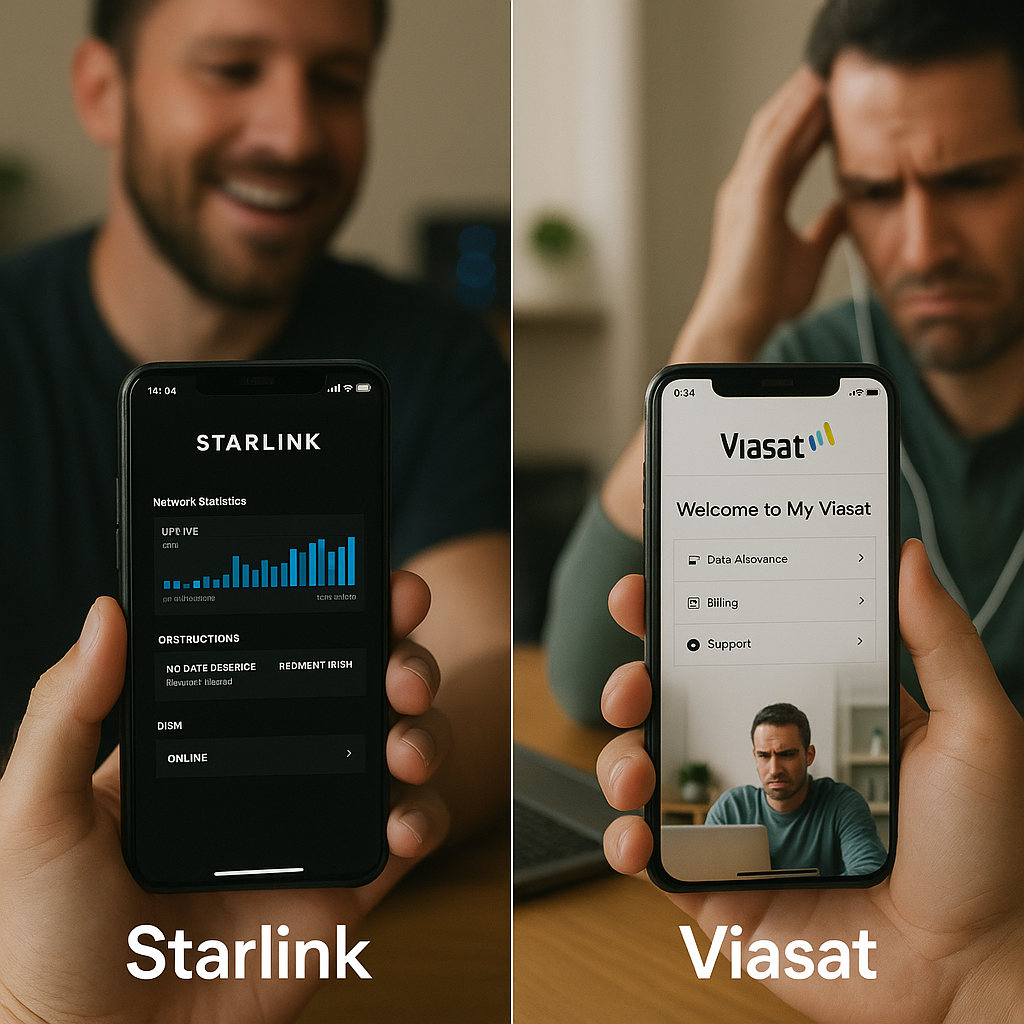
Viasat vs Starlink – Best Satellite Internet 2025
I never thought choosing a satellite internet provider could feel this complicated. But here we are in 2025, and suddenly, I’m comparing orbital constellations and data caps just to get a decent connection out in the countryside.
Two names always come up: Viasat vs Starlink. I’ve used both. And trust me, the difference isn’t just about speed — it’s about how each one fits into your daily life, especially if you live where traditional fiber or cable don’t reach.
If you’re trying to figure out which one is better for your needs — gaming, Zoom calls, watching Netflix without buffering — this breakdown will help you decide. Let’s kick things off by talking about what matters most to most people: the price.
Internet Plans and Pricing
Monthly Pricing Breakdown
When I first looked into satellite internet, I was shocked by how different the pricing models are.
Viasat offers structured plans starting at around $70/month, going all the way up to $150/month depending on speed and data. Their pricing feels like a traditional cable model — more expensive plans come with higher speed caps and priority data. But once you cross your data limit, things slow down fast.
Starlink, on the other hand, has a much simpler setup. Their residential plan is a flat $120/month in most areas. It’s all-you-can-eat internet with no formal data caps — which, as someone who works online all day, is a huge relief. No slowdowns. No counting gigs.
Honestly, if you’re after unlimited usage without surprises, Starlink’s flat rate feels more fair — even if the price tag is a bit higher upfront.
Equipment Costs and Installation Fees
Here’s where Starlink hits hard: that $599 equipment fee. It includes the satellite dish (aka “Dishy”), router, and mounting hardware. It’s a one-time charge, but it stings when you’re just trying to get online.
Viasat doesn’t ask for that much upfront. In most cases, the installation is either free or heavily discounted with a 2-year contract. You might pay $99–300 if you go month-to-month or want extra gear, but it’s more manageable upfront.
That said, Starlink’s gear is user-friendly and future-proof. Once I set it up, I didn’t touch it again — no service calls, no tech visits.
Hidden Fees and Contracts
Viasat has some fine print that caught me off guard. If you cancel early, expect termination fees up to $400. Also, unless you choose their highest-tier plan, you’ll likely face speed throttling after hitting your data allowance.
Starlink? No contracts. You can cancel anytime without fees. Their pricing is more transparent — and frankly, I appreciated that.
If you’re tired of the old-school ISP tricks, Starlink feels like a breath of fresh air.
Speed, Latency, and Performance
Download and Upload Speed Comparison
When I first tested both services, the difference in speed was immediate.
Starlink gave me download speeds ranging from 100 to 250 Mbps, with upload speeds around 15 to 25 Mbps. That’s faster than many rural DSL or 4G setups, and it was consistent enough to stream, work, and game without any real slowdowns.
Viasat, on the other hand, offered 30 to 100 Mbps on most plans, but it came with a catch — those speeds only held up until I hit my data threshold. Once that “priority data” ran out, speeds dropped to 1–5 Mbps, which made even YouTube a pain.
If raw speed is what you’re after, Starlink clearly wins.
Real-Time Latency and Gaming Experience
Now, here’s where satellite usually falls flat: latency.
With Viasat, I saw latency levels hovering around 600–800 ms — that’s almost a full second of delay. For gaming, real-time Zoom calls, or remote work where timing matters? It’s tough. I couldn’t play even casual multiplayer games without rubberbanding all over the place.
Starlink, thanks to its low-Earth orbit satellites, stays around 30–70 ms, which is game-changing. I played Fortnite, joined video calls, and even used remote desktop tools without noticeable lag.
If you’re a gamer or rely on live apps, Starlink is the only viable satellite option right now.
Performance During Bad Weather or Peak Hours
Let’s be honest — satellite internet will always be sensitive to the sky.
In my experience, both providers dipped slightly during heavy storms. Viasat would slow down or buffer during thick cloud cover, and Starlink sometimes lost connection entirely for a minute or two in severe weather.
But overall? Starlink bounced back faster. Its newer tech and constantly updating constellation helped it recover quicker. Viasat felt more fragile — especially during peak hours when their older network got congested.
So while neither is perfect in bad weather, Starlink holds the edge in stability and recovery.
Availability and Coverage
Viasat’s Satellite Network and Footprint
Viasat has been around longer, and that’s clear when you look at its coverage map. It’s available pretty much anywhere in the U.S., even deep rural areas where cellular signal is weak. I used it once in a remote Colorado cabin — and while it wasn’t blazing fast, it worked.
They use geostationary satellites that cover large areas, which helps with reach but increases latency. Their older infrastructure isn’t built for modern, high-speed demands — it’s more of a lifeline for places that have no other options.
If you’re in a completely off-grid location, Viasat probably still has you covered. But speed and responsiveness? That’s another story.

Starlink’s Constellation and Rural Reach
Now here’s where Starlink flips the game.
Using a massive network of low-Earth orbit satellites, it provides coverage to nearly all of North America and is rapidly expanding worldwide. The difference is that it doesn’t just “cover” an area — it actually delivers usable, fast internet, even in places traditional providers ignore.
I tested it in a tiny rural town in New Mexico, and I was shocked. Speeds held up. Latency stayed low. I joined Zoom meetings without a hitch.
That said, Starlink availability still depends on capacity per region. In some congested zones, new signups may be waitlisted. But where it’s open, it works beautifully.
Service Limitations by Region
Both providers have their weak spots.
Viasat can technically serve more regions, but your experience will depend on your plan and how crowded the satellite beam is. In high-demand areas, expect throttled speeds and longer outages.
Starlink sometimes limits availability due to network load, and coverage in heavily forested or mountainous areas can be shaky unless you have a clear sky view. When I tried to set it up near a dense tree line, I had to mount the dish higher just to get signal lock.
Installation, Setup, and Equipment
Self-Install vs Professional Setup
When it came to setup, the difference between the two providers was like night and day.
With Viasat, a technician came to install the dish. The process took about 2 hours, including drilling and aligning the satellite. It was hands-off for me, but it also meant waiting a few days for the appointment — and if you reschedule, it can take even longer.
Starlink ships everything to your door in a sleek, Apple-like box. I had it up and running within 30 minutes. No installer, no appointment — just follow the app and mount the dish in a clear spot. For someone who likes doing things on their own schedule, this was perfect.
If you’re comfortable with basic DIY, Starlink’s self-install is smoother and faster.

Antenna/Dish Technology Differences
Viasat’s dish is old-school — large, bulky, and needs precise alignment. It’s designed for geostationary satellites, so once it’s locked in, it doesn’t move. That’s great for stability, but not for adaptability.
Starlink’s dish — affectionately called “Dishy” — is smart. It auto-aligns using motors and sensors to track low-Earth orbit satellites that are constantly moving overhead. Watching it rotate during setup was honestly impressive.
Also, Starlink’s equipment is weather-resistant and more modern-looking. I didn’t feel like I was mounting something from the early 2000s on my roof.
Maintenance and Support
Viasat’s dish may require periodic realignments or technician visits, especially after storms or strong winds. I had to call support once after a windy week knocked the signal off slightly — and they charged me for the visit.
Starlink’s dish has no moving parts exposed, fewer failure points, and updates itself via firmware. I’ve had mine for a year, and haven’t touched it since day one. If you need help, most troubleshooting is done through the app or support portal — no calls required.
From setup to long-term care, Starlink feels like the more modern, low-maintenance option.
Customer Experience and Satisfaction
User Reviews and Reputation
Before I tried either provider, I did what everyone does — I searched Reddit, forums, and review sites.
Viasat had a common theme: frustration. Most complaints were about throttling, data caps, and long wait times for tech support. Some folks were happy in very remote areas with no alternatives, but overall, the vibe was that Viasat “gets the job done, but barely.”
Starlink, on the other hand, had an almost cult following. People praised its speed and simplicity — especially in areas with zero broadband access. There were some complaints about equipment cost and waitlists in congested areas, but performance-wise, reviews were strong.
If online reputation matters to you, Starlink has a much more positive buzz in the real world.

Support Channels and Responsiveness
Viasat operates like a traditional ISP. You call, you wait on hold, you explain your issue five times to three different reps. I went through this cycle when my speeds tanked during a billing cycle — not fun.
Starlink skips phone support entirely. It’s all handled through their support portal and app. At first, I was skeptical. But the responses came within 24–48 hours, and they were straight to the point. I had a dish issue once, and they shipped a replacement within a week — no arguments.
So while Viasat offers more traditional support options, Starlink’s in-app service is faster and more efficient — as long as you’re okay with no phone line.
App Interface and Control Features
Viasat’s app is basic. You can view bills, check your usage, and maybe restart your modem — that’s it. It feels outdated and clunky, with slow loading times.
Starlink’s app is far more modern. You can:
- Check satellite visibility
- Monitor real-time speed stats
- Run diagnostics
- View obstructions
- Reboot your router
All in a slick, easy-to-use interface. It even helps with setup by showing you the best place to mount your dish.
From a user experience perspective, Starlink feels years ahead.
Final Verdict – Which One Should You Pick?
After using both Viasat and Starlink in different locations — from quiet rural towns to forested cabin areas — I can tell you this: Starlink is the future of satellite internet, and it’s already leaving Viasat behind.
If you want reliability, high speeds, and a setup you can manage yourself, Starlink delivers. It’s not perfect — the equipment cost is high, and service availability depends on your region — but once you’re connected, it feels like a real broadband experience. No caps, no lag, no drama.
Viasat, on the other hand, still plays by the old rules. You’ll deal with contracts, data throttling, and slower speeds. It’s okay if Star link isn’t available in your area yet — but it’s clearly a stopgap, not a long-term solution.
FAQ on Viasat vs Starlink
You have questions, we have answers

Jane Smith
John Doe is a seasoned tech enthusiast with over a decade of experience in the telecommunications industry. With a passion for understanding the ins and outs of internet service providers and a knack for breaking down complex tech topics, John has helped thousands of consumers make informed decisions about their home services. In addition to his work as a freelance writer, John enjoys exploring the latest gadgets, staying updated on internet technology trends, and providing insightful reviews. When he’s not working, you’ll find him experimenting with new tech or enjoying a good book.